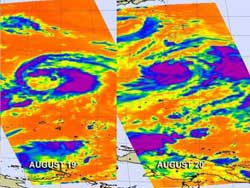NASA watches as Tropical Storm Bolaven develops

NASA's Aqua satellite has been monitoring the birth and progress of Tropical Storm Bolaven in the western North Pacific from Aug. 19-20. The AIRS instrument has provided infrared satellite imagery that shows the development of colder thunderstorm cloud-top temperatures that were indicative of strengthening storms.<br><br>Credit: NASA JPL, Ed Olsen<br>
NASA's Aqua satellite has been monitoring the birth and progress of Tropical Storm Bolaven in the western North Pacific from Aug 19-20, 2012. The Atmospheric Infrared Sounder (AIRS) instrument has provided infrared satellite imagery that shows the development of colder thunderstorm cloud-top temperatures, that were indicative of strengthening storms. Tropical Storm Bolaven also took more of a rounded shape on August 20 as it continued to organize and intensify.
On August 19 at 03:11 UTC (Aug. 18 at 11:11 p.m. EDT) the AIRS image of Bolaven appeared loosely organized. At that time, the strongest thunderstorms appeared to be east of the center of circulation.
On August 20 at 3:53 UTC (Aug. 19 11:53 p.m. EDT), NASA's AIRS instrument on the Aqua satellite captured another infrared image of Bolaven. The infrared AIRS image showed the storm had a much tighter circulation and Bolaven's strongest thunderstorms were south of the center of circulation, where cloud top temperatures were colder than -63 Fahrenheit (-52 Celsius). Hours later, Bolaven was located about 400 nautical miles (460 miles/741 km) south of Iwo To, Japan, near 18.2 North latitude and 141.2 West longitude. It was moving to the north-northwest at 5 knots (5.7 mph/9.2 kmh) and had maximum sustained winds near 35 knots (40 mph/65 kmh).
Bolaven will continue strengthening as it moves to the west-northwest over the next couple of days in open waters of the western North Pacific Ocean. By August 24 forecasters at the Joint Typhoon Warning Center expect Bolaven to reach typhoon status.
Media Contact
More Information:
http://www.nasa.govAll latest news from the category: Earth Sciences
Earth Sciences (also referred to as Geosciences), which deals with basic issues surrounding our planet, plays a vital role in the area of energy and raw materials supply.
Earth Sciences comprises subjects such as geology, geography, geological informatics, paleontology, mineralogy, petrography, crystallography, geophysics, geodesy, glaciology, cartography, photogrammetry, meteorology and seismology, early-warning systems, earthquake research and polar research.
Newest articles

Trotting robots reveal emergence of animal gait transitions
A four-legged robot trained with machine learning by EPFL researchers has learned to avoid falls by spontaneously switching between walking, trotting, and pronking – a milestone for roboticists as well…

Innovation promises to prevent power pole-top fires
Engineers in Australia have found a new way to make power-pole insulators resistant to fire and electrical sparking, promising to prevent dangerous pole-top fires and reduce blackouts. Pole-top fires pose…

Possible alternative to antibiotics produced by bacteria
Antibacterial substance from staphylococci discovered with new mechanism of action against natural competitors. Many bacteria produce substances to gain an advantage over competitors in their highly competitive natural environment. Researchers…





















